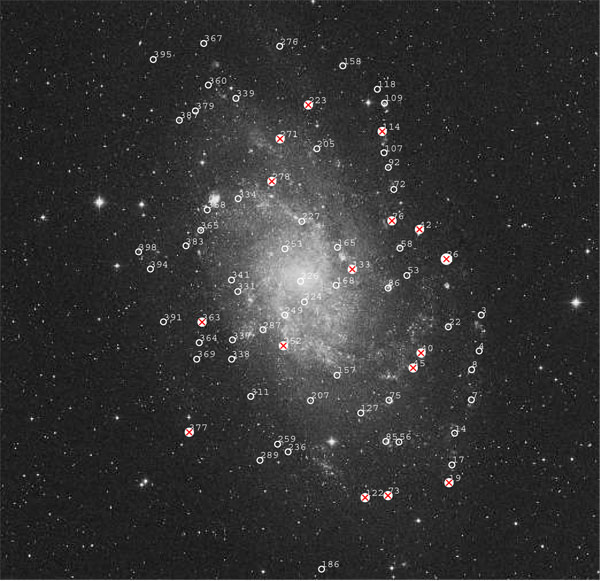 | |||
|
| Home > Public Information > Scientific Highlights > 2007 > The Metallicity Gradients of M 33 |
The Metallicity Gradients of M 33 | ||
|
WHT+AF2
The galaxy M 33 (NGC 598) is the third-brightest member of the Local Group. Its closeness, its large angular size, and its intermediate inclination make it particularly suitable for studies of spiral structure, interstellar medium (ISM), and of stellar populations.
Being a late-type spiral galaxy, it has a rich population of H II regions. Observations with the INT telescope, covering an area of approximately 0.6 square degrees, produced the most complete catalog of H II regions in this galaxy.
Recently, ING's Local Group Census project (LGC) obtained new imaging observations of M 33. These new deep data cover about 2 square degrees and are allowing to discover a conspicuous number of new H II regions at large galactocentric distances. The existence of chemical abundance gradients in M 33 was known from long time, but its origin, shape and magnitude are still open issues. Using AF2 on the WHT, a team of astronomers investigated the chemical and physical properties of a large sample of H II regions of different sizes, galactocentric distances and excitations and to study their behaviour through the disk.
In total, they analyzed optical spectra of 72 emission-line objects in M 33, including mostly H II regions, but also five SNRs and two candidate PNe. The direct Te determination was possible for 15 H II regions by the measurements of the [O III] 436.3 nm line and in three of them of the [N II] 575.5 nm line. For the 14 H II regions with determined Te and with detection of both [O II] and [O III] lines they derived chemical abundances. They also collected oxygen abundances from young stars presented in a large number of objects representative of the present time interestellar medium metallicity to draw a complete picture of the shape and magnitude of the metallicity gradient, and they found the best fit to the data using two different slopes, corresponding to the central regions R<3 kpc (-0.19±0.08 dex kpc-1) and outer regions R≥3kpc (-0.038 ±0.015dex kpc-1). The shallower outer gradient is in agreement with several new works and it can be explained with a slow continuous accretion of the disk of M 33 from the intergalactic medium that continues to present time. References:
|
| Top | Back |
|


